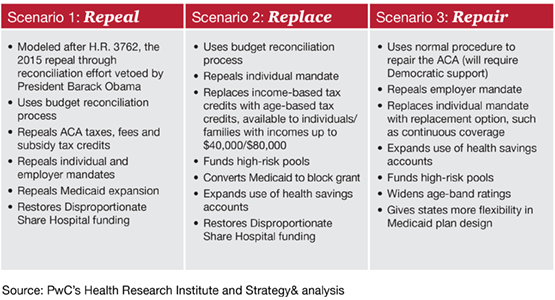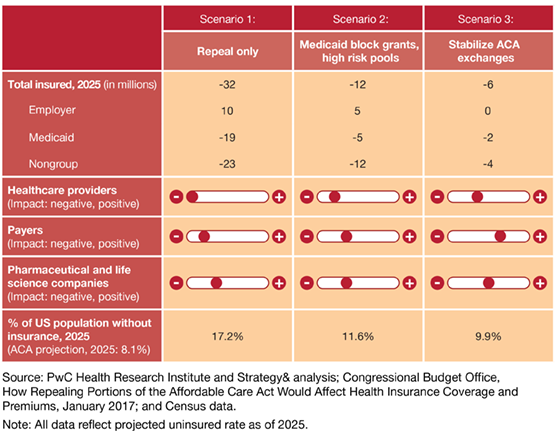Any similarities of the title of this blog and Goldilocks and the Three Bears belies the serious decisions needed for the next round of healthcare reform. Last month, PwC’s Health Research Institute (HRI) released another fantastic research piece that maps out three possible landing spots: repeal, replace, repair. The full 54-page report is found HERE and well worth the read. With Round Two of AHCA happening in the House of Representatives, this report outlines the potential impact of healthcare reform tactics.
With so many proposals being discussed in Washington, lawmakers seemingly could take an infinite number of routes in addressing the ACA. Policy changes could be packaged into a single comprehensive bill, or rolled out in a piecemeal fashion as a series of administrative actions, stand-alone legislation and moves by state legislatures.
Repeal, Replace, Repair
Yet, three scenarios for addressing the ACA seem most likely, no matter the regulatory and legislative paths taken to reach to each, according to modeling conducted by PwC’s Health Research Institute (HRI). The wide range of potential outcomes for likely legislation highlights the need to model the possibilities, and evaluate their consequences. An analysis of these three scenarios found that they produce dramatically different outcomes.
Repeal
In one scenario, lawmakers could “repeal” by cutting budget-related provisions of the ACA through a process known as budget reconciliation without including their own replacement health-reform provisions. This would be the path closest to erasing the ACA altogether. Lawmakers also could opt to keep the ACA largely intact, choosing to “repair” it by adjusting and improving the 2010 law, a legislative process that likely would require some Democratic support.
Outcome: Once fully implemented by 2025, likely would leave an estimated 32 million more Americans uninsured than would be under the ACA.
Replace
Lawmakers also could take a more middle-ground approach, opting to “replace” the law by repealing its budget-related provisions through budget reconciliation and replacing them with Republican-favored policies, such as Medicaid block grants. Any actions taken by lawmakers likely will fall along a continuum into one of these scenarios.
Outcome: “Replace” likely would leave 12 million more Americans uninsured by 2025 than would be under the ACA.
Repair
To understand the implications of any legislation moving through Congress, industry stakeholders can focus on these three scenarios and their potential outcomes and start drafting smart, resilient strategies for surviving — and even capitalizing on — what comes next. Understanding each of these policies’ implications is the key to planning for them.
Outcome: Under “repair,” the ranks of the uninsured likely would grow by 6 million by 2025, compared to what would be expected under the ACA.
About PwC’s Health Research Institute
PwC’s Health Research Institute (HRI) provides new intelligence, perspectives and analysis on trends affecting all health-related industries. The Health Research Institute helps executive decision-makers navigate change through primary research and collaborative exchange. Our views are shaped by a network of professionals with executive and day-to-day experience in the health industry. HRI research is independent and not sponsored by businesses, government or other institutions.


